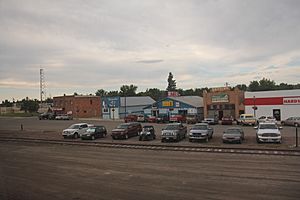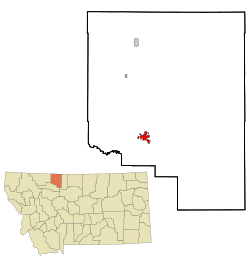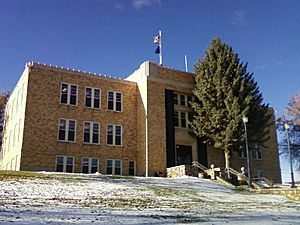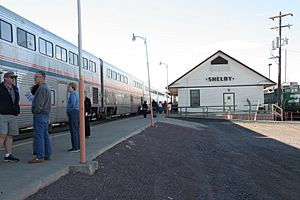Shelby, Montana facts for kids
Quick facts for kids
Shelby, Montana
|
|
|---|---|

Downtown Shelby
|
|

Location of Shelby, Montana
|
|
| Country | United States |
| State | Montana |
| County | Toole |
| Area | |
| • Total | 5.96 sq mi (15.43 km2) |
| • Land | 5.78 sq mi (14.97 km2) |
| • Water | 0.17 sq mi (0.45 km2) |
| Elevation | 3,297 ft (1,005 m) |
| Population
(2020)
|
|
| • Total | 3,169 |
| • Density | 548.08/sq mi (211.63/km2) |
| Time zone | UTC-7 (Mountain (MST)) |
| • Summer (DST) | UTC-6 (MDT) |
| ZIP code |
59474
|
| Area code(s) | 406 |
| FIPS code | 30-67450 |
| GNIS feature ID | 0776465 |
Shelby is a city in and the county seat of Toole County, Montana, United States. The population was 3,169 at the 2020 census.
Contents
History
Shelby was named in honor of Peter O. Shelby, General Manager of the Montana Central Railway. A railroad station was established here about 1892, at the junction of the Great Northern Railway and the Great Falls & Canada Railway.
On July 4, 1923, the town hosted a heavyweight boxing match between Jack Dempsey and Tommy Gibbons for the undisputed world Heavyweight boxing championship title. This event almost bankrupted the town of Shelby.
In the early 2000s the town hosted a dog camp that made national news. It was named Camp Collie and helped mistreated dogs.
Welker Farms, an agricultural operation known for its popular social media channels, is located near Shelby.
The Well Done Foundation, which plugs orphaned and abandoned oil wells, opened a visitors' center in Shelby in 2020.
Geography
Shelby is near the Marias River and also Aloe Lake.
According to the United States Census Bureau, the city has a total area of 6.18 square miles (16.01 km2), of which 6.03 square miles (15.62 km2) is land and 0.15 square miles (0.39 km2) is water.
Climate
Shelby has four distinct seasons, and is considered an arid climate. Long, severe winters give way to springlike weather anywhere from March to May. Summers can be dry and hot, and the area is prone to lightning, hail, and severe thunderstorms during the summer months. Fall weather is often unpredictable, with snow falling during October some years, and temperatures well into the 60s °F (10s °C) stretching until the end of November on other years. Due to the city's location just off of the Rocky Mountain Front, wind is a constant.
Climate data is sparse. A weather station operated in the town from the late 1990s shows slightly higher temperatures than nearby towns such as Cut Bank.
| Climate data for Shelby, Montana, 1991–2020 normals, extremes 1950–present | |||||||||||||
|---|---|---|---|---|---|---|---|---|---|---|---|---|---|
| Month | Jan | Feb | Mar | Apr | May | Jun | Jul | Aug | Sep | Oct | Nov | Dec | Year |
| Record high °F (°C) | 69 (21) |
69 (21) |
78 (26) |
86 (30) |
91 (33) |
97 (36) |
102 (39) |
103 (39) |
96 (36) |
89 (32) |
74 (23) |
65 (18) |
103 (39) |
| Mean maximum °F (°C) | 55.3 (12.9) |
55.9 (13.3) |
64.4 (18.0) |
74.3 (23.5) |
83.8 (28.8) |
88.9 (31.6) |
96.2 (35.7) |
95.7 (35.4) |
89.9 (32.2) |
78.2 (25.7) |
64.6 (18.1) |
54.1 (12.3) |
96.4 (35.8) |
| Mean daily maximum °F (°C) | 31.4 (−0.3) |
35.5 (1.9) |
43.9 (6.6) |
54.2 (12.3) |
64.4 (18.0) |
72.6 (22.6) |
82.2 (27.9) |
82.2 (27.9) |
70.9 (21.6) |
56.2 (13.4) |
42.0 (5.6) |
33.1 (0.6) |
55.7 (13.2) |
| Daily mean °F (°C) | 18.8 (−7.3) |
22.6 (−5.2) |
31.2 (−0.4) |
41.3 (5.2) |
51.2 (10.7) |
59.3 (15.2) |
66.8 (19.3) |
65.8 (18.8) |
55.7 (13.2) |
42.6 (5.9) |
29.8 (−1.2) |
21.1 (−6.1) |
42.2 (5.7) |
| Mean daily minimum °F (°C) | 6.1 (−14.4) |
9.9 (−12.3) |
18.4 (−7.6) |
28.4 (−2.0) |
38.0 (3.3) |
46.0 (7.8) |
51.5 (10.8) |
49.3 (9.6) |
40.5 (4.7) |
29.0 (−1.7) |
17.6 (−8.0) |
9.1 (−12.7) |
28.7 (−1.9) |
| Mean minimum °F (°C) | −21.6 (−29.8) |
−13.8 (−25.4) |
−5.7 (−20.9) |
13.0 (−10.6) |
23.4 (−4.8) |
35.1 (1.7) |
42.0 (5.6) |
38.5 (3.6) |
26.9 (−2.8) |
10.0 (−12.2) |
−5.7 (−20.9) |
−16.8 (−27.1) |
−28.4 (−33.6) |
| Record low °F (°C) | −44 (−42) |
−37 (−38) |
−37 (−38) |
−9 (−23) |
12 (−11) |
30 (−1) |
36 (2) |
30 (−1) |
16 (−9) |
−12 (−24) |
−31 (−35) |
−36 (−38) |
−44 (−42) |
| Average precipitation inches (mm) | 0.46 (12) |
0.36 (9.1) |
0.63 (16) |
1.34 (34) |
1.77 (45) |
2.85 (72) |
1.14 (29) |
0.85 (22) |
1.01 (26) |
0.74 (19) |
0.52 (13) |
0.46 (12) |
12.13 (309.1) |
| Average snowfall inches (cm) | 7.3 (19) |
5.8 (15) |
6.9 (18) |
4.1 (10) |
1.9 (4.8) |
0.0 (0.0) |
0.0 (0.0) |
0.0 (0.0) |
0.5 (1.3) |
1.4 (3.6) |
5.5 (14) |
5.5 (14) |
38.9 (99.7) |
| Average precipitation days (≥ 0.01 in) | 5.1 | 5.4 | 6.0 | 7.3 | 9.3 | 11.1 | 5.8 | 5.7 | 6.1 | 5.4 | 4.6 | 5.2 | 77.0 |
| Average snowy days (≥ 0.1 in) | 4.2 | 4.1 | 3.1 | 1.8 | 0.5 | 0.0 | 0.0 | 0.0 | 0.1 | 0.7 | 2.6 | 3.7 | 20.8 |
| Source 1: NOAA | |||||||||||||
| Source 2: National Weather Service | |||||||||||||
Demographics
| Historical population | |||
|---|---|---|---|
| Census | Pop. | %± | |
| 1920 | 537 | — | |
| 1930 | 2,004 | 273.2% | |
| 1940 | 2,538 | 26.6% | |
| 1950 | 3,058 | 20.5% | |
| 1960 | 4,017 | 31.4% | |
| 1970 | 3,111 | −22.6% | |
| 1980 | 3,142 | 1.0% | |
| 1990 | 2,763 | −12.1% | |
| 2000 | 3,216 | 16.4% | |
| 2010 | 3,376 | 5.0% | |
| 2020 | 3,169 | −6.1% | |
| U.S. Decennial Census | |||
2010 census
At the 2010 census there were 3,376 people in 1,245 households, including 717 families, in the city. The population density was 559.9 inhabitants per square mile (216.2/km2). There were 1,371 housing units at an average density of 227.4 per square mile (87.8/km2). The racial makeup of the city was 89.5% White, 0.8% African American, 6.5% Native American, 0.5% Asian, 0.8% from other races, and 1.9% from two or more races. Hispanic or Latino of any race were 3.0%.
Of the 1,245 households 28.3% had children under the age of 18 living with them, 43.8% were married couples living together, 9.2% had a female householder with no husband present, 4.7% had a male householder with no wife present, and 42.4% were non-families. 37.4% of households were one person and 14% were one person aged 65 or older. The average household size was 2.17 and the average family size was 2.84.
The median age was 40.3 years. 18.9% of residents were under the age of 18; 8.3% were between the ages of 18 and 24; 29.3% were from 25 to 44; 29.9% were from 45 to 64; and 13.6% were 65 or older. The gender makeup of the city was 58.3% male and 41.7% female.
Education
Shelby Public Schools educates students from kindergarten through 12th grade. In the 2021-2022 school year, Shelby High School had 112 students enrolled. The school's team name is the Coyotes.
Toole County Library is a public library in Shelby.
Media
The Shelby Promoter is the newspaper for Shelby. It is printed weekly and also offers an e-edition.
Two radio stations are licensed in Shelby. KSEN AM 1150 and KZIN-FM 96.7 are both owned by Townsquare Media.
Infrastructure
At Shelby station, Amtrak, the national passenger rail system, provides daily service to Shelby (both east and west), operating its Empire Builder from Chicago to Seattle and Portland, Oregon. The freight rail yard is known as the Port of Northern Montana.
Shelby is at the intersection of Interstate 15 and U.S. Route 2.
Northern Transit Interlocal, local bus transportation system. Provides transportation to Great Falls & Kalispell.
Shelby Airport is a county-owned airport two miles north of town. The nearest commercial airport is Great Falls International Airport, 86 miles (138 km) south.
Notable people
- James Grady, author - born and grew up in Shelby. He was on the staff of Senator Lee Metcalf.
- Leroy Hood, scientist associated with the Human Genome Project grew up here.
- Jack Horner, paleontologist, was born here.
- Larry Krystkowiak, former NBA player (1986–1996), grew up here.
See also
 In Spanish: Shelby (Montana) para niños
In Spanish: Shelby (Montana) para niños




